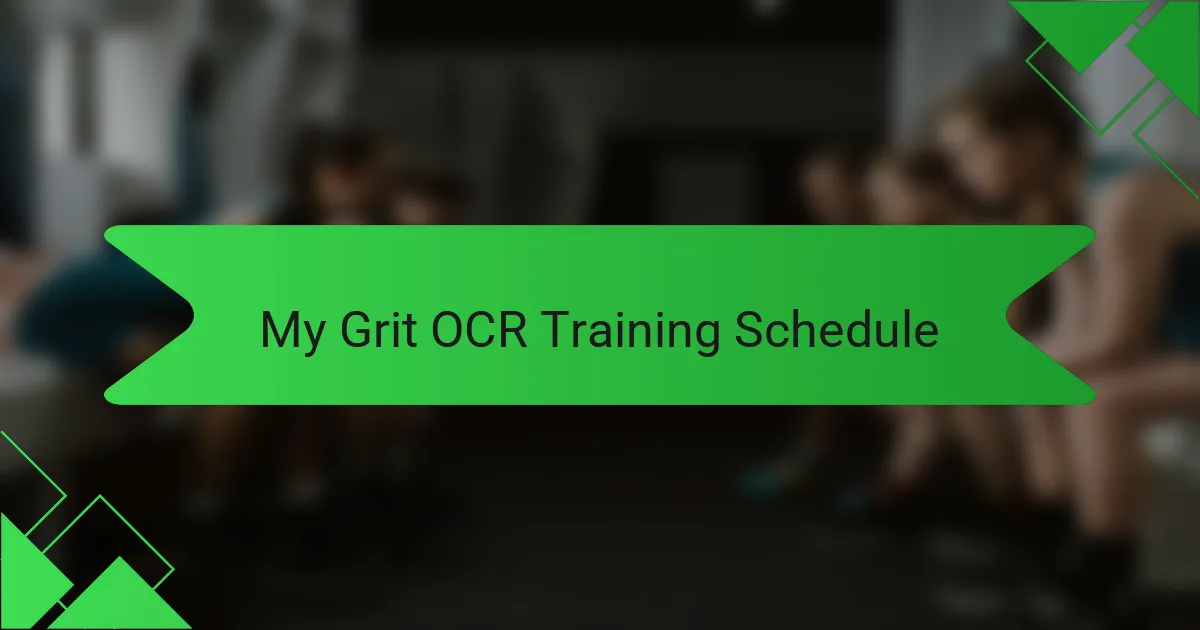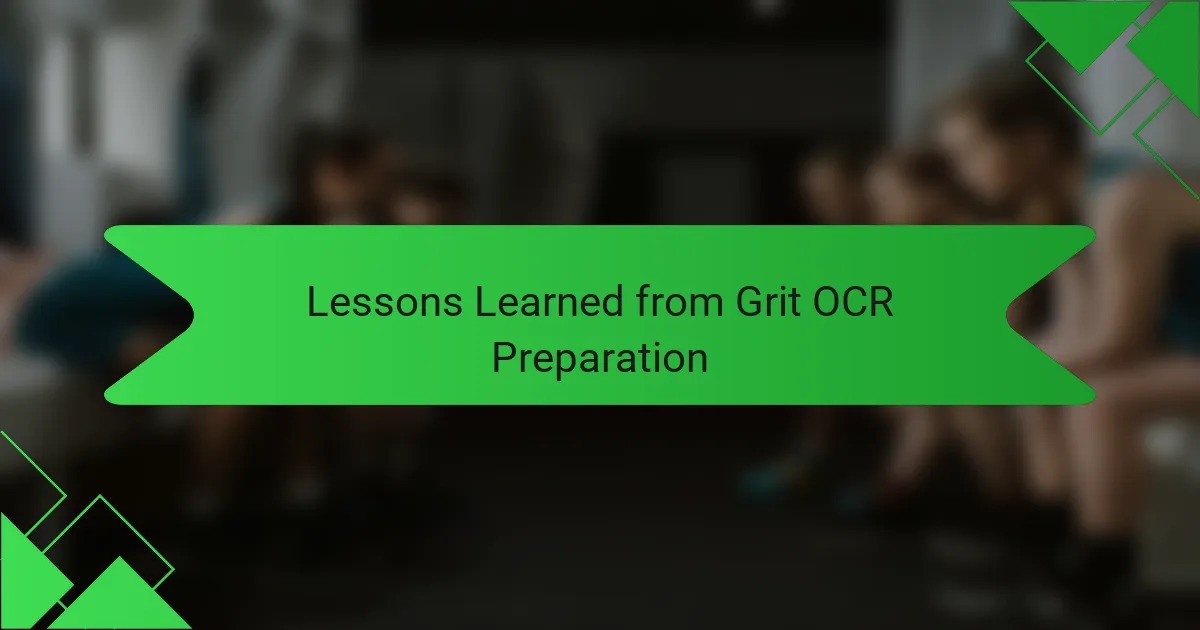Key takeaways
- Obstacle Course Racing (OCR) combines running with diverse physical challenges, testing both physical strength and mental toughness.
- Effective training for OCR includes building functional strength, endurance, grip strength, and agility for better obstacle navigation.
- Proper nutrition, including hydration and balanced macronutrients, is essential for sustained energy and performance during races.
- Mental preparation techniques like visualization and positive self-talk are crucial for boosting confidence and resilience on race day.

What is Obstacle Course Racing
Obstacle Course Racing (OCR) is a thrilling mix of running and tackling various physical challenges. From my experience, it’s not just about speed but grit—pushing through tough obstacles like climbing walls, crawling through mud, and swinging across ropes. Each race tests both your strength and mental toughness in ways that traditional running never does.
What makes OCR so unique is the variety and unpredictability of the obstacles. You never quite know what’s next, which keeps your adrenaline high and your mind sharp. Here’s a quick look at the core elements you face in OCR:
- Running on diverse terrains like mud, sand, and trails
- Climbing over walls and rope nets
- Crawling under barbed wire or through tight spaces
- Carrying heavy objects such as sandbags or logs
- Balancing across beams or other narrow surfaces
- Jumping and swinging between platforms or ropes
Every race feels like a fresh challenge, and that uncertainty is what hooked me from the start. It’s a true test of both body and mind.

Essential Training Components for OCR
When I first started training for OCR, I realized quickly that just running wasn’t enough. Building functional strength through exercises like pull-ups, deadlifts, and sled pushes made a huge difference in how I tackled obstacles. Strength doesn’t just help you climb walls or carry heavy loads—it gives you the confidence to face whatever the course throws at you.
Endurance is another piece of the puzzle. I used to think long runs were enough, but OCR demands short bursts of intense effort mixed with steady pacing. Incorporating interval training and trail runs helped me adapt to the unpredictable terrain and recover quickly between obstacles. Have you ever felt winded halfway through a race? I have, and improving endurance has been key to avoiding that pitfall.
Finally, grip strength and agility often fly under the radar but trust me, they’re game changers. Working on grip with farmer’s carries and practicing balance drills gave me the upper hand on rope swings and narrow beams. Without this focus, those final obstacles that look easy from afar feel insurmountable when you’re exhausted. Would I skip grip training now? Absolutely not—it’s saved me countless times on the course.

Nutrition for Obstacle Course Racing
Nutrition for Obstacle Course Racing is more than just eating healthy; it’s about fueling your body with the right balance of energy to conquer every challenging obstacle. When I trained for Grit OCR, I quickly realized that carb-loading the night before wasn’t enough—I needed sustained energy from real, nutrient-dense foods that would keep me going strong from start to finish.
One of my key takeaways was how hydration and electrolyte balance played a huge role in how I felt mid-race. Skimping on electrolytes led to cramping during training, which was frustrating and hurt my confidence. Over time, I learned to focus on a mix of complex carbs, lean proteins, and plenty of hydration infused with electrolytes to avoid that sluggish, drained feeling.
Here’s a nutrition checklist I relied on for Grit OCR:
- Carbohydrates: whole grains, sweet potatoes, and oats to provide steady energy
- Proteins: lean meats, eggs, and plant-based sources to support muscle repair
- Healthy fats: avocados, nuts, and seeds for sustained endurance
- Hydration: water combined with electrolyte-rich drinks to maintain balance
- Vitamins and minerals: plenty of fruits and vegetables to support recovery and immune function
This approach gave me real confidence on race day, knowing my body was ready to tackle every obstacle with strength and endurance.

Gear and Equipment Selection
Choosing the right gear felt like assembling a toolkit tailored just for Grit OCR. I learned the hard way that lightweight, quick-drying fabrics were a must—nothing worse than carrying soggy clothes through mud and water obstacles. Have you ever worn cotton on a wet course? If you have, you know exactly how uncomfortable that can be.
Footwear was another critical decision. I opted for trail running shoes with aggressive tread and solid drainage. They gave me the traction I needed on slippery surfaces and kept my feet from feeling like bricks halfway through the race. I can’t count how many times good shoes saved me from a nasty slip or foot cramp.
Then there’s the practical side of gear like gloves and backpacks. I decided on fingerless gloves—they protected my hands without sacrificing grip. And a lightweight hydration pack kept me fueled without slowing me down. Looking back, each piece of equipment wasn’t just gear; it was part of my strategy for pushing through every grueling obstacle.

Mental Preparation Techniques
Mental preparation was just as crucial as my physical training for Grit OCR. I practiced visualization daily, imagining myself tackling each obstacle confidently, which helped reduce my anxiety on race day. This mental rehearsal made the challenges feel less daunting and boosted my resilience when fatigue set in.
I also used positive self-talk to keep my motivation high, especially during long runs. At times when I felt overwhelmed, reminding myself of past achievements kept my mindset strong and focused. This mental toughness is, in my experience, what separates finishing the race from just starting it.
| Mental Technique | How I Applied It |
|---|---|
| Visualization | Imagined completing obstacles flawlessly to build confidence |
| Positive Self-Talk | Used encouraging phrases to maintain focus and motivation |
| Mindfulness | Stayed present to manage stress and avoid overthinking |

My Grit OCR Training Schedule
My Grit OCR training schedule became my new obsession. I broke it into focused sessions: strength work, endurance runs, and technique drills for obstacles. Sticking to this routine wasn’t easy, but every sweaty, sore day felt like progress toward the finish line.
| Day | Training Focus |
|---|---|
| Monday | Strength Training (pull-ups, carries, muscle ups) |
| Wednesday | Endurance Runs (5-8 miles with hills) |
| Friday | Obstacle Technique Practice (walls, ropes, monkey bars) |
| Saturday | Long Trail Run + Trail Navigation |

Lessons Learned from Grit OCR Preparation
Lessons Learned from Grit OCR Preparation
Preparing for Grit OCR taught me the critical importance of balancing strength and endurance. Initially, I focused too much on running, which left me struggling with the challenging obstacles. It was only when I integrated targeted grip and upper body workouts that I truly felt ready and confident on race day.
I also realized that mental toughness is just as vital as physical readiness. During my training, pushing through moments of doubt and fatigue built the resilience I needed to conquer the course. This mental edge made all the difference, turning hurdles into opportunities instead of roadblocks.
| Aspect | My Experience |
|---|---|
| Strength Training | Started late, realized it was crucial for obstacles requiring grip and upper body power. |
| Endurance Running | Focused on early but adjusted to balance with strength exercises. |
| Mental Preparation | Built through consistent practice and pushing through low moments. |
